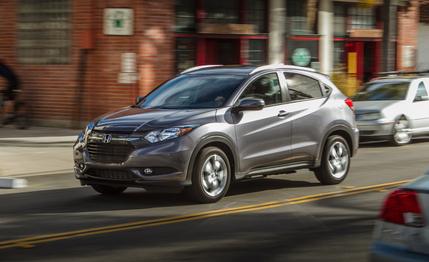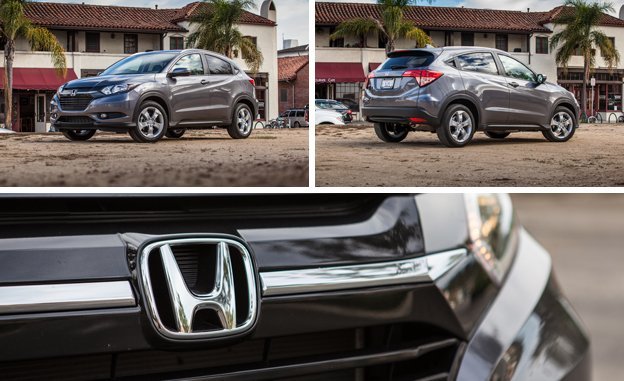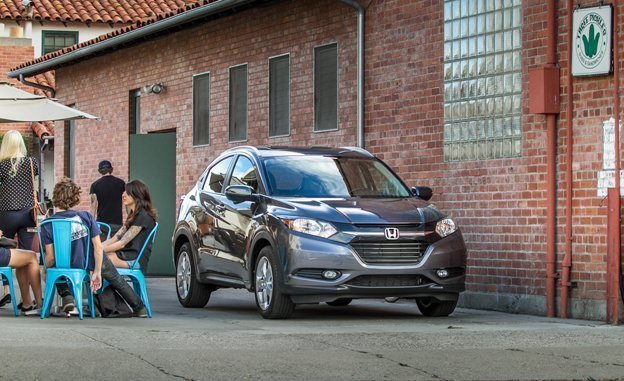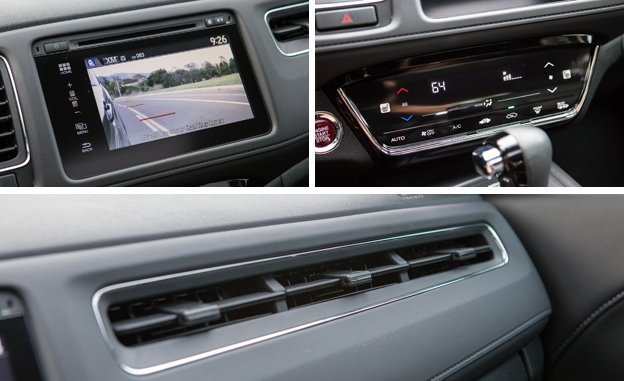 Instrumented Test
From the June 2015 issue
Instrumented Test
From the June 2015 issue
The HR-V draws deeply on past and present. In many ways, it’s a throwback to the best things 20th-century Honda ever did, such as elegant interiors, sweet suspension tuning, and well-considered details. And then it goes all Kendrick-Lamar-pimpin’-butterflies for its powertrain, electronics, even its very concept: This Honda is merely the latest to join the growing ranks of 21st-century micro-utes.
What exactly constitutes a crossover is elusive when shrunk to twerp size. Nissan’s Juke is self-consciously quirky; the Chevrolet Trax is handsomely uncomplicated; Jeep’s new Renegade mixes rugged heritage with adorable details; what exactly Fiat is doing with the 500X is, uh, interesting; and the upcoming Mazda CX-3 looks unpretentiously promising. But even if this is a messy newborn segment whose rules await discipline, the baby crossover is clearly the economy car of right now.

The biggest kid in this space is the exceedingly precious Kia Soul, which sells about 10,000 units a month in the United States, doesn’t offer four-wheel drive, and is marketed with anthropomorphic hamsters. In contrast, the HR-V proffers elegance: restrained interior and exterior design that doesn’t court attention yet manages to be good-looking and substantial anyhow.
Honda hadn’t announced pricing for the HR-V as this was written, only promising that it would start under $20,000 and peak somewhere in the mid-to-high 20s for a loaded EX-L like our test vehicle. The HR-V should be on sale at dealerships as you read this.
Based on the Fit platform and built alongside it at Honda’s plant in Celaya, Mexico, the HR-V is conventional in most of its mechanical details. There are struts up front and a torsion beam in the back, and the engine sits transversely under the hood. Like the Fit, the HR-V cleverly tucks its fuel tank under the driver’s seat, where it’s surrounded by protective steel plating.

The HR-V is, however, significantly larger than the Fit. At 102.8 inches, the wheelbase is 3.2 inches longer than its donor’s. And at 169.1 inches, it’s 9.1 inches lengthier overall. It’s also a bit more than six inches longer than a Soul or Juke. But the HR-V is still more than 10 inches shorter than its big brother, the ludicrously popular CR-V.
Larger dimensions lead to some additional heft. This four-wheel-drive EX-L with leather and navigation weighed 3098 pounds —465 pounds more than a Fit with a CVT—which creates the need for some additional power. So the Fit’s pokey engine, a 130-hp 1.5-liter DOHC four, was set aside in favor of pokey-plus. That is, a 141-hp 1.8-liter SOHC four. While both engines feature 16 valves and Honda’s signature i-VTEC variable-valve-timing-and-lift system, only the Fit’s uses direct injection. And the HR-V’s engine looks particularly wan in comparison with the turbocharged 1.6 in the Juke, which is rated at 188 horsepower.
Honda’s build quality is apparent even before opening the driver’s door. The panels all fit tightly on this preproduction test car, the 17-inch wheels look expensive, and there’s no orange peel in the paint. Honda surrounds the entire bottom edge of the HR-V in black plastic—across the bumper covers, along the rockers, and around the wheel arches—making the vehicle look as if it’s riding higher than it is. But the claimed 6.7 inches of unloaded ground clearance (4.7 inches fully loaded) is modest. It’s smart to just stay off the trails.
 The cabin is beautiful and well trimmed, and the vent is long indeed. But let's have some real HVAC and radio knobs to twirl, please.
The cabin is beautiful and well trimmed, and the vent is long indeed. But let's have some real HVAC and radio knobs to twirl, please.
What’s best about the HR-V is inside, including elements such as the straightforward instrumentation grouped under a single binnacle. Simple shapes form the door panels; and the sweet, bright trim around the vents seems downright sophisticated. The seat cushions are short, but the leather covering them is soft and well stitched. After Honda’s goofball adventures into awkward cabin designs (the Civic’s two-tiered dashboard, for example), the HR-V’s restrained style counts as something of a return to form.
Particularly appreciated is the large vent that runs across the dash in front of the right-seat passenger. It’s a true compliment to say it really blows. Problematically, though, most of the usual control buttons are missing in action. In their place is a touch-sensitive five-inch LCD screen and touch-sensitive black panel for the ventilation system. Stylistically, it’s sleekly Bauhaus. Practically, it makes trying to change a radio station while wearing gloves tough.
Redundant audio and navigation controls—real switches—on the nicely padded steering wheel are the driver’s default controls. Why risk frustration by dealing with the touch screen?